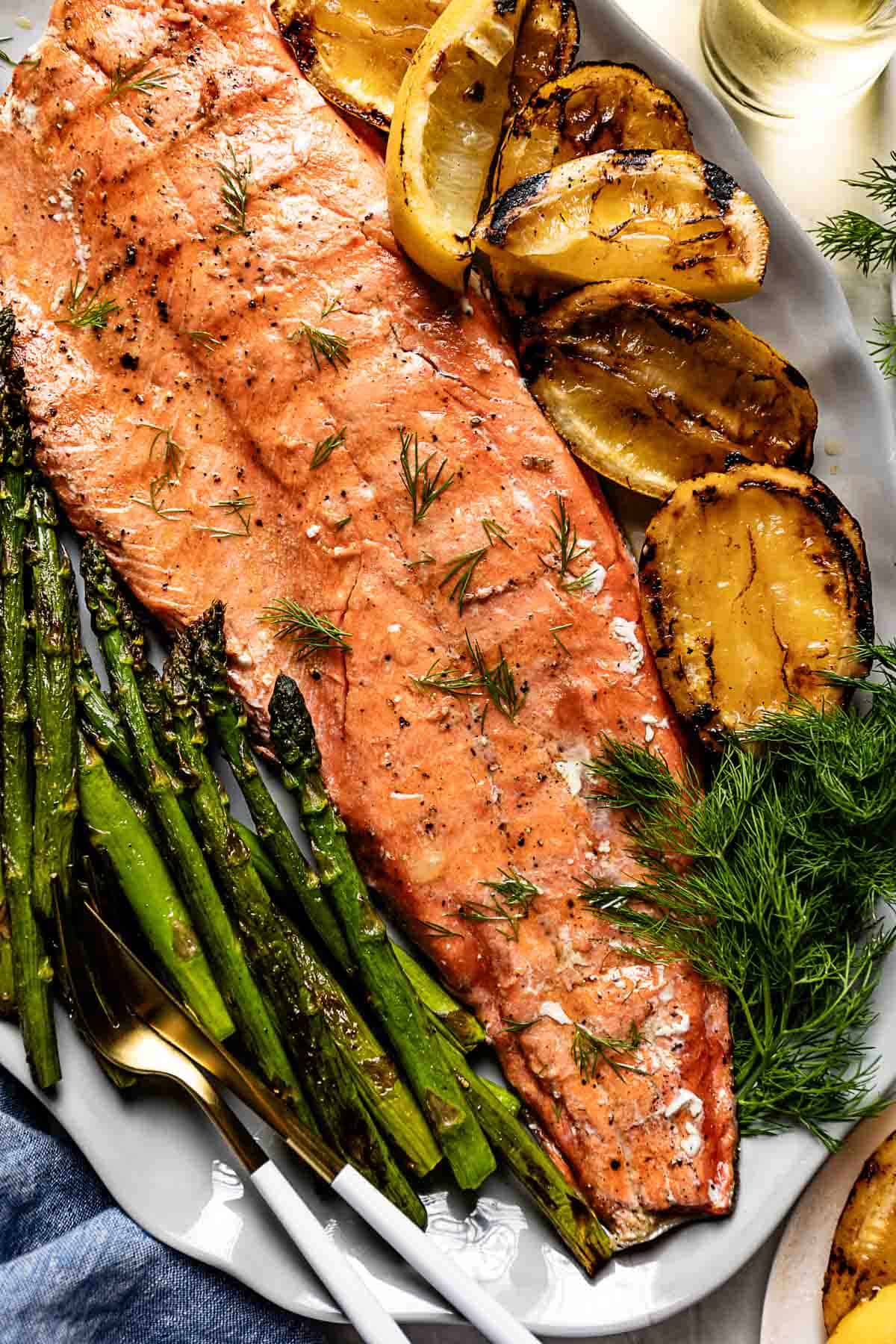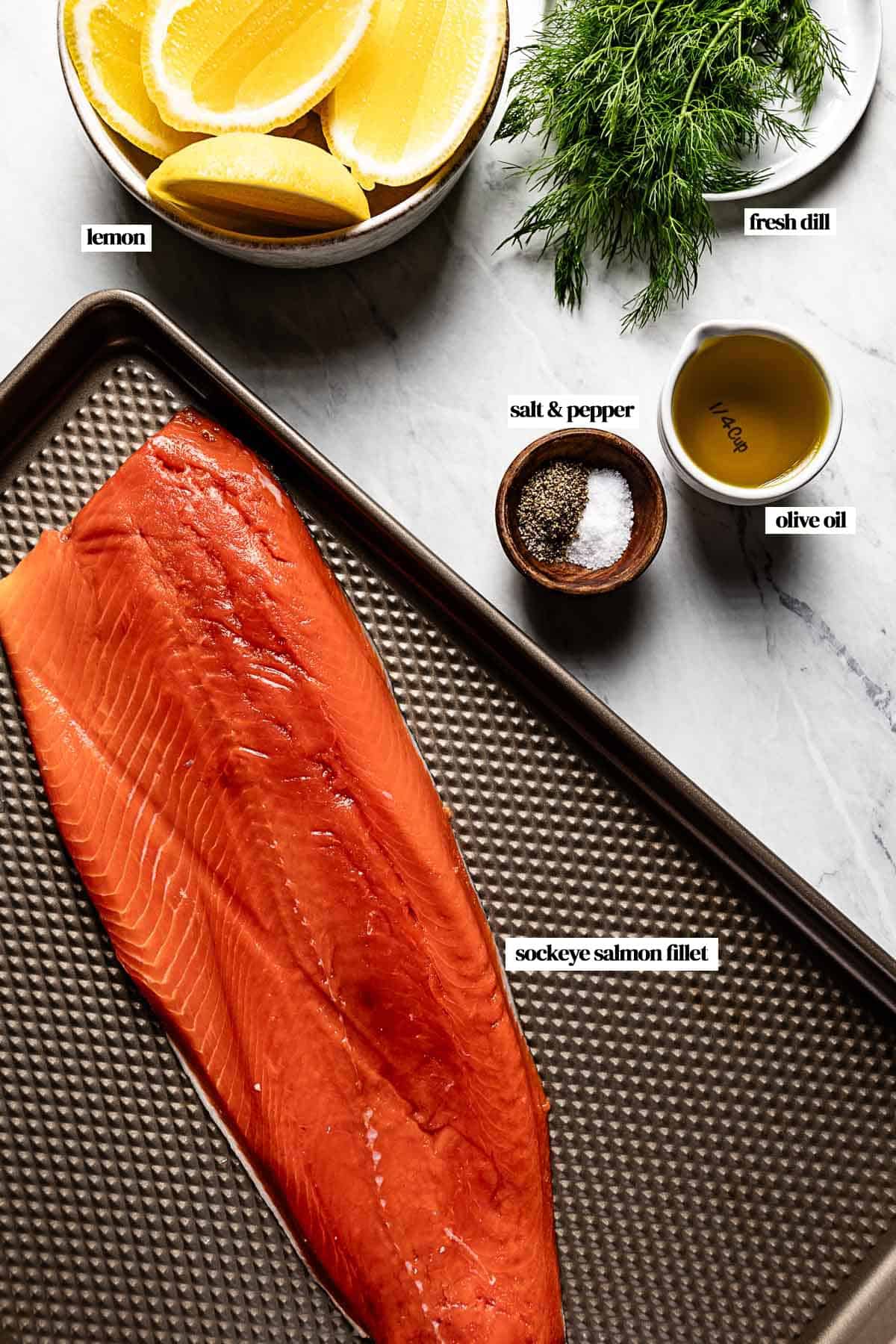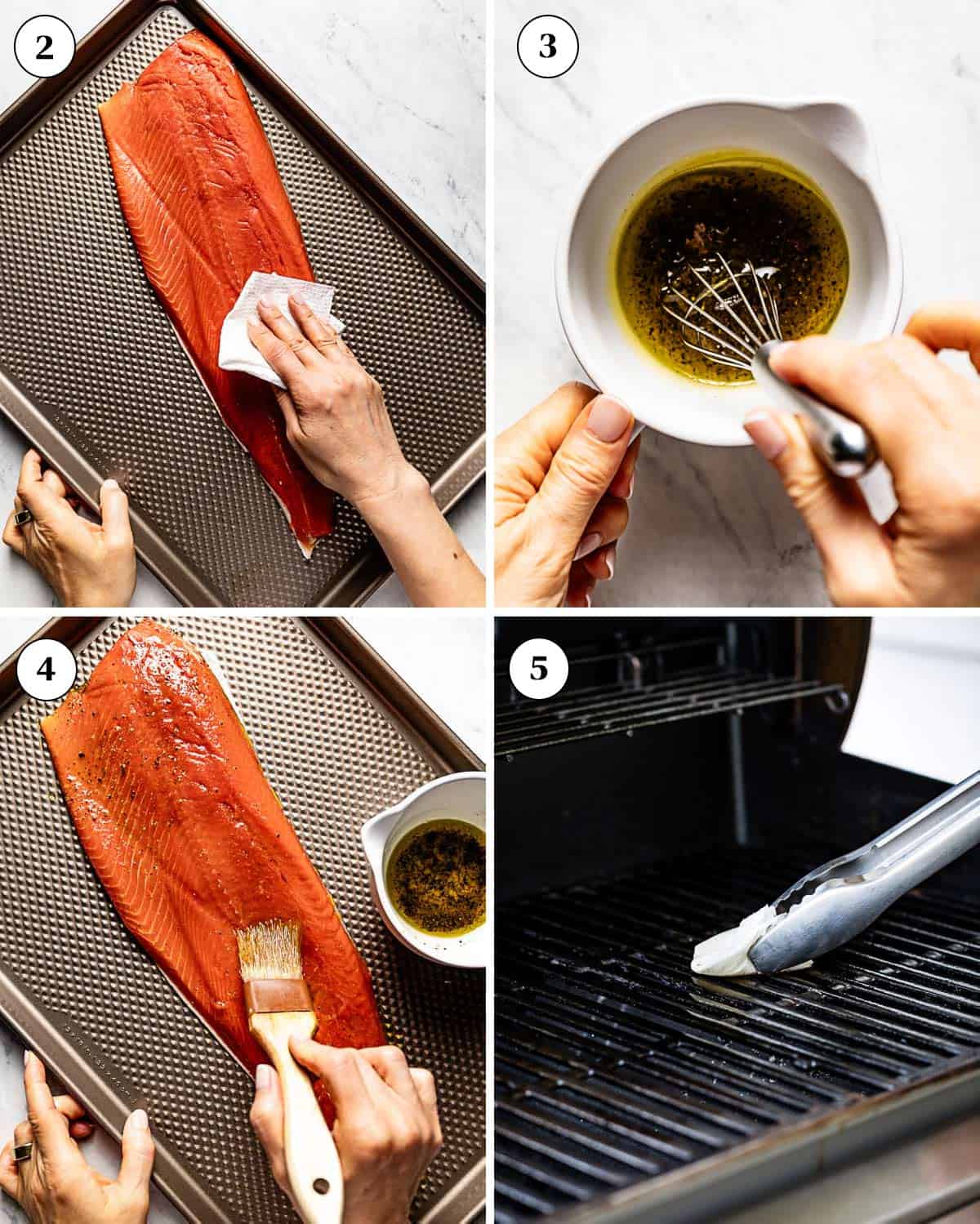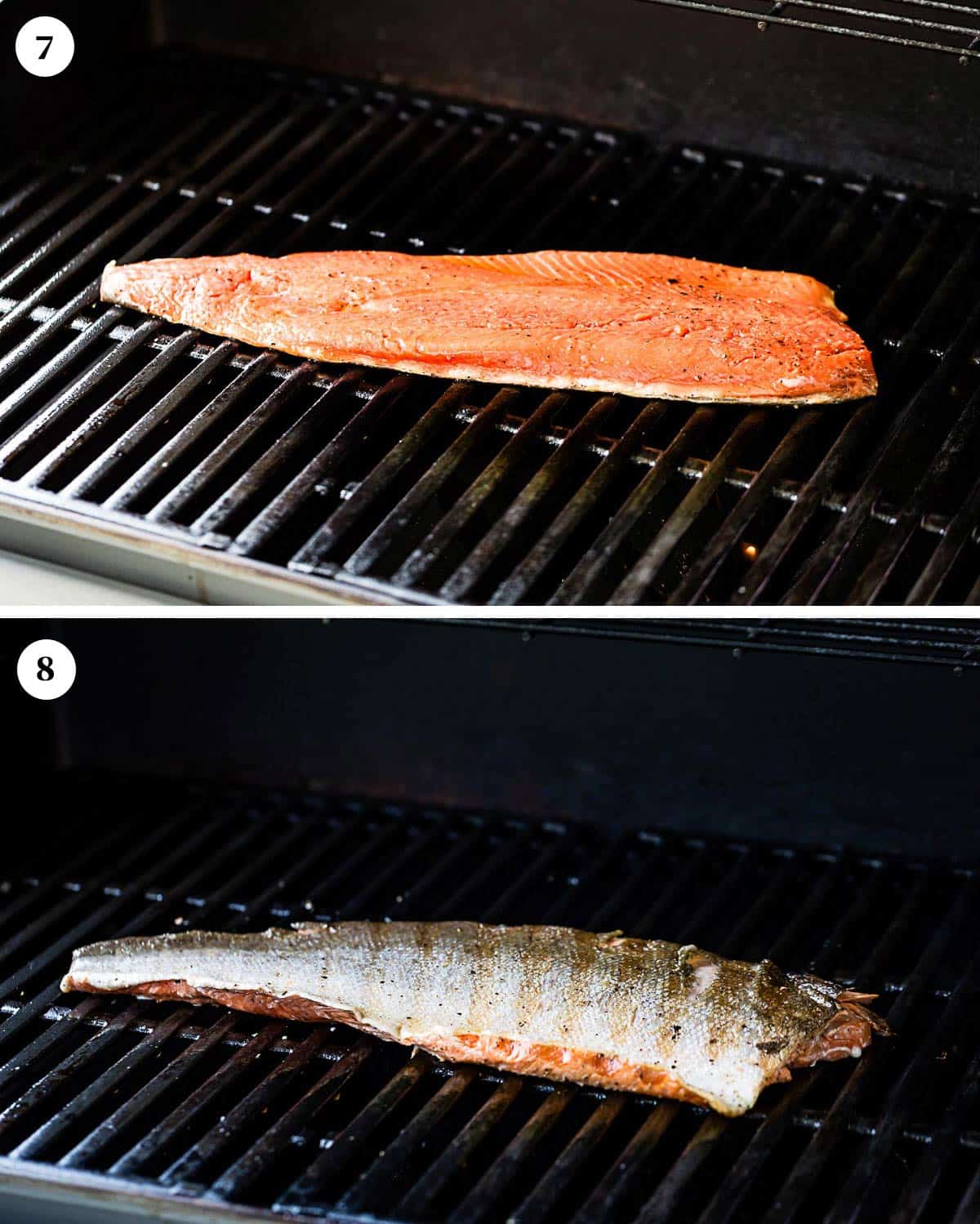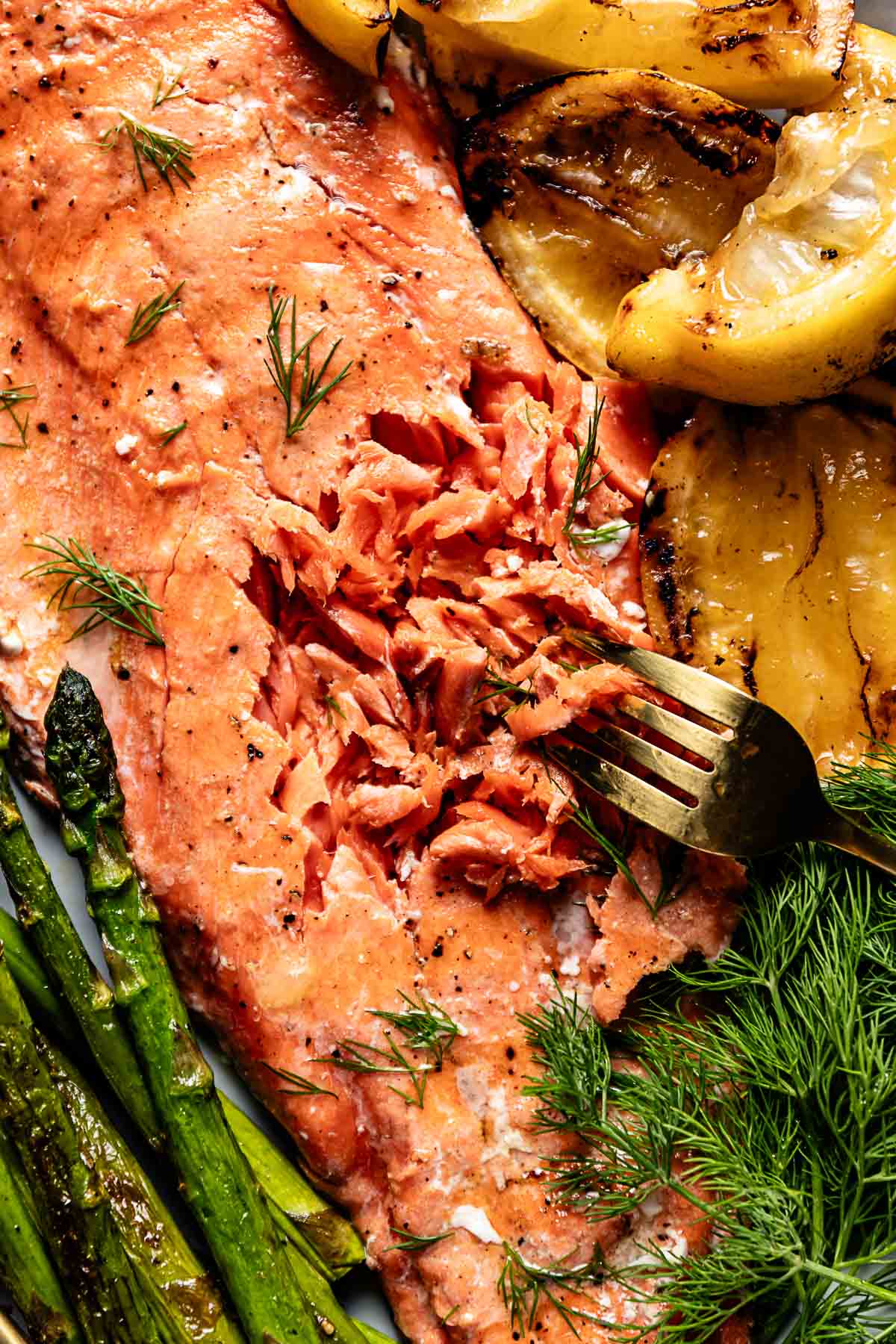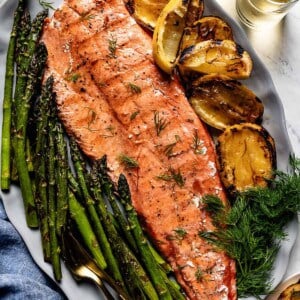Ingredients You’ll Need
To prepare this smoky recipe for fresh sockeye salmon on the grill, you only need two sets of simple ingredients—fish and seasoning. For the fish:
Wild Alaskan sockeye salmon: I prefer a fresh, whole salmon fillet for this recipe, though you may also use pre-cut fillets if you prefer easier salmon portions. Red salmon tends to be in season from May through July, but if you want to make this dish out-of-season or don’t have access to fresh alternatives, you can also use frozen sockeye salmon fillets. Just be sure to thaw them fully before roasting them.
For seasoning: I use a very basic seasoning mixture to prepare my sockeye salmon for grilling. Because, if you have ever cooked it, you know that Pacific salmon is already delicious by itself and doesn’t need much. So, in terms of seasoning, this easy recipe uses a handful of ingredients you likely already have in your pantry, but it will give your grilled salmon an irresistibly light, zesty, and robust flavor profile.
Olive oil Lemon juice Kosher salt and freshly ground black pepper Garlic or garlic powder: Though optional, this pantry-ready addition adds bold, smoky undertones to this BBQ sockeye salmon recipe. Simply add it on top of your fillets or mix it into your seasoning mixture before brushing your fish. However, fresh minced garlic easily burns over high heat, so keep in mind that this addition may result in slightly charred notes in your seasoning for sockeye salmon. Fresh Herbs: I like to sprinkle my grilled salmon with fresh dill, but any fresh herbs you like and have on hand would work for this recipe. Lemon Slices: Serve it with fresh lemon slices or grill them for the dreamy char and grill marks.
How to Grill Sockeye Salmon on a Gas Grill?
This grilled sockeye salmon recipe is a godsend for quick, delicious meals. With this effortless guide, you’ll enjoy tender, flavorful grilled fillets in under ten minutes.
What to Serve With Grilled Alaskan Salmon?
Grilling sockeye salmon is a great way to get diverse, smoky meals all summer long. This collection of tasty sides—from tender potatoes to tangy salsas—pairs excellently with this heart-healthy meal.
Storage: To store your grilled salmon fillet, let it reach room temperature. Then, transfer it to an airtight container and place it in the refrigerator for up to two days. Reheat: The secret to keeping your leftover grilled salmon from drying out is to reheat it in a low-heat oven—preferably 300 degrees F.—for 2-3 minutes or until warmed through.
Grilled vegetables: Nearly any veggie would work as a side when you grill wild salmon. I particularly love to serve this fish recipe alongside grilled asparagus and grilled zucchini, and Mexican Street Corn is a creamy, flavorful side no one can resist. You can also grill the lemons of this recipe for added presentation and to give your fish an enticing smokiness, though this step is optional. Salsa and sauces: Adding sauce is an easy way to add delectable complexity to this simply grilled salmon recipe. Grilled salmon with Pineapple Salsa is a classic dish for summertime barbecue. But for a more robust, rich flavor, you can also serve your fillets with my five-minute Garlic Butter Sauce. Salads: You can serve this red sockeye salmon recipe with any of my tasty summer salads. However, my favorites include a tangy, crisp Yogurt Cucumber Salad and my crowd-friendly, healthy Mayo-Free Coleslaw. Potatoes: For a classic potato salad dressed to impress, my Red Potato Salad will compliment your fish with a perfect mix of savory, creamy, and fresh flavors. Or, if you want to put a salty, gourmet spin on your dinner menu, Caper Potato Salad will lend a complex mix of briny pickles, robust mustard, and tender potatoes to your table.
Have more questions about how to cook Alaska salmon? This hassle-free guide will answer all your queries, from salmon preparation to grilling time.
Good-quality fish: I learned during my visit with the folks over at Copper River Salmon that the best way to turn a simple sockeye salmon recipe into a gourmet meal is by selecting high-quality fish. If you’re using fresh fish, it’s best to cook it within the first 24-48 hours for the brightest, most mouthwatering flavors. However, if you prefer frozen fillets, fully thaw them before roasting—preferably by storing them in the fridge overnight. Preheat the grill: Ensure your grill preheats to 350 degrees F. before adding your salmon. Because salmon cooks quickly, transferring the fish too early will result in overly cooked, dry fillets. Clean and grease the grill grates well: For best results, it’s essential that you thoroughly clean and oil your grill grates before adding your salmon. If you don’t generously grease your grates, your fish will stick to the grill, making it difficult to flip and remove the fillets. Keep the skin on: The skin on your sockeye salmon fillet provides an excellent fatty barrier that keeps the flesh from overcooking when exposed to high temperatures. Therefore, I highly recommend keeping the skin on while grilling. Plus, it peels off easily after the cooking process. Do not move: The key to perfectly cooked salmon is to leave the fillet on the grill grates, skin-side-down, without touching it during the grilling process. Once the salmon cooks fully, it will release itself from the grates, and your spatula should fit easily under it without tearing its flesh. Use two spatulas: If you are new to grilling a whole fish fillet, we recommend using two large spatulas (fish spatulas (affiliate link) are best if you have them) when flipping it. It is easier to flip them when you have ample support. Grilled sockeye salmon in foil: We tested this recipe using a sheet of aluminum foil as well. There was no difference in the cooking time but the flavor lacked some of the smokiness. However, if you prefer to grill salmon in foil, be sure to grease the foil pieces with an oil spray first. Then, transfer the salmon to the middle of the foil and grill using the recipe instructions as written. The thickness of the fish: In general, sockeye salmon is thinner than Atlantic salmon, resulting in less time on the grill. However, if your salmon is thicker, you might have to add more cooking time to ensure fully cooked fillets (and vice versa). Check the doneness: The secret to a moist sockeye salmon recipe is not to overcook it. Keep in mind that salmon cooks so quickly. According to the folks over at America’s Test Kitchen, the ideal internal temperature for perfectly grilled sockeye salmon is 120-125 degrees F. Marinade: Because this wild Alaskan salmon recipe packs so many robust, natural flavors, there’s no need to marinate your fish beforehand. However, if you want a different flavor profile, brush your fillets after grilling with a sweet-and-spicy Honey Mustard Glaze or a flavorful Maple Ginger Glaze for a tangy Asian take on this classic dish.
Other Grilled Seafood Recipes You Might Like
Tempted to make grilled salmon every night of the week? These other grilled fish dishes will satiate your seafood cravings with their delectably moist, fresh, and bright flavors.
Shrimp Vegetable Kabobs Grilled Mahi Mahi Shrimp Skewers
If you try this Grilled Sockeye Salmon recipe or any other recipe on Foolproof Living, please take a minute to rate the recipe and leave a comment below. It is a great help to others who are thinking of making the recipe. And if you took some pictures, be sure to share them on Instagram using #foolproofeats so I can share them on my stories.

